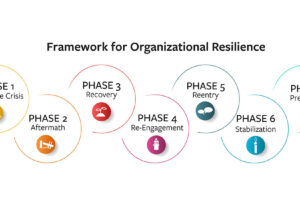Today's Top Picks

Why AI Must Include Community Voices
By improving speed, effectiveness, and efficiency, AI offers vital support for emergency management’s resource-constrained, rapid decision-making needs. Shaping everything from risk assessment and hazard planning to grant evaluation, AI can revolutionize emergency management.

The Case for a Victim-Centered Approach to Mass Violence Preparedness
Mass violence incidents, though statistically uncommon, have become more frequent in the United States in recent years and leave lasting effects on impacted communities. No community is immune, making a victim-centered, trauma-informed mass violence incident plan essential for recovery.

Podcast – From Threat to Recovery: Integrating Cybersecurity into the Incident Command System
October marks National Cybersecurity Awareness Month, and this week’s episode of Domestic Preparedness: The Podcast dives into the challenges of safeguarding communities from evolving cyber threats. Host Teresa Farfan sits down with Bart Taylor, cybersecurity training manager at the Texas A&M Engineering Extension Service (TEEX), to explore practical strategies for integrating cybersecurity into emergency management, and the importance of collaboration among technology professionals, risk managers, and emergency managers in reporting, managing, and mitigating cyber incidents.

Emergency Response Strategies for Autonomous Vehicle Incidents
Autonomous vehicles can face rare situations that they are not fully programmed to handle. Because their driving mistakes differ from those of humans, first responders must adjust their tactics accordingly. In support of first responders and public safety, the Texas Department of Transportation commissioned guidelines and procedures for autonomous vehicle-related incidents.

Securing U.S. Food & Agriculture’s Critical Supply Chains
Although one of the nation’s 16 critical infrastructure sectors, the food and agriculture sector has long trailed others in resilience. With globalized supply chains and vital ties to preparedness and stability, this lag is untenable. Disruptions—from cyberattacks to disasters and trade shocks—highlight its fragility and security risks.
Trending
 FIFA, Terrorism, and Preparedness for the 2026 World… by Adam Johnson The quadrennial championship of the most popular game in the world—soccer—is coming to the United States in 2026, and fans…
FIFA, Terrorism, and Preparedness for the 2026 World… by Adam Johnson The quadrennial championship of the most popular game in the world—soccer—is coming to the United States in 2026, and fans… The Evolving Landscape of Domestic Extremism by Richard Schoeberl Extremism in its many forms remains a growing threat in the U.S. There is heightened concern about ongoing violent extremist…
The Evolving Landscape of Domestic Extremism by Richard Schoeberl Extremism in its many forms remains a growing threat in the U.S. There is heightened concern about ongoing violent extremist… Preparing Small Communities for Terrorist Attacks by Rodney Andreasen Terrorist attacks have broad psychological, social, and economic impacts that often extend beyond the initial target. While large cities are…
Preparing Small Communities for Terrorist Attacks by Rodney Andreasen Terrorist attacks have broad psychological, social, and economic impacts that often extend beyond the initial target. While large cities are… A Seven-Phase Framework for Organizational Resilience by Michelle Colosimo Organizations cannot always dictate the course of a crisis—whether an incident, active threat, or natural disaster—but they can shape their…
A Seven-Phase Framework for Organizational Resilience by Michelle Colosimo Organizations cannot always dictate the course of a crisis—whether an incident, active threat, or natural disaster—but they can shape their…Trending
 Preparing Small Communities for Terrorist Attacks by Rodney Andreasen Terrorist attacks have broad psychological, social, and economic impacts that often extend beyond the initial target. While large cities are…
Preparing Small Communities for Terrorist Attacks by Rodney Andreasen Terrorist attacks have broad psychological, social, and economic impacts that often extend beyond the initial target. While large cities are… A Seven-Phase Framework for Organizational Resilience by Michelle Colosimo Organizations cannot always dictate the course of a crisis—whether an incident, active threat, or natural disaster—but they can shape their…
A Seven-Phase Framework for Organizational Resilience by Michelle Colosimo Organizations cannot always dictate the course of a crisis—whether an incident, active threat, or natural disaster—but they can shape their… FIFA, Terrorism, and Preparedness for the 2026 World… by Adam Johnson The quadrennial championship of the most popular game in the world—soccer—is coming to the United States in 2026, and fans…
FIFA, Terrorism, and Preparedness for the 2026 World… by Adam Johnson The quadrennial championship of the most popular game in the world—soccer—is coming to the United States in 2026, and fans… The Evolving Landscape of Domestic Extremism by Richard Schoeberl Extremism in its many forms remains a growing threat in the U.S. There is heightened concern about ongoing violent extremist…
The Evolving Landscape of Domestic Extremism by Richard Schoeberl Extremism in its many forms remains a growing threat in the U.S. There is heightened concern about ongoing violent extremist…Trending
FIFA, Terrorism, and Preparedness for the 2026 World… by Adam Johnson The quadrennial championship of the most popular game in the world—soccer—is coming to the United States in 2026, and fans…
The Evolving Landscape of Domestic Extremism by Richard Schoeberl Extremism in its many forms remains a growing threat in the U.S. There is heightened concern about ongoing violent extremist…
Preparing Small Communities for Terrorist Attacks by Rodney Andreasen Terrorist attacks have broad psychological, social, and economic impacts that often extend beyond the initial target. While large cities are…
A Seven-Phase Framework for Organizational Resilience by Michelle Colosimo Organizations cannot always dictate the course of a crisis—whether an incident, active threat, or natural disaster—but they can shape their…
Domestic Preparedness Journal
Featured in this issue
- Volunteers—A Necessary Force Multiplier
- Hidden Assets and Ready Relationships
- Volunteers and Emergency Management Budgets
- Indigenous Emergency Response in Canada
- Civil Defense: The Unseen Pillars of Preparedness
- The United Cajun Navy and Industry Partnerships
- Emergency Management and Homeland Security
- Life Lessons Learned in Kindergarten
- A Free Mental Health Resource
- Overcoming Hurricane Evacuation Delays
- Podcast – CERT and Community Preparedness
- Podcast – Leading in Times of Disaster
- Podcast – Partnerships in Preparedness
Articles Out Loud

Why AI Must Include Community Voices
October 8, 2025
By improving speed, effectiveness, and efficiency, AI offers vital support for emergency management’s resource-constrained, rapid decision-making needs. Shaping everything from

The Case for a Victim-Centered Approach to Mass Violence Preparedness
October 8, 2025
Mass violence incidents, though statistically uncommon, have become more frequent in the United States in recent years and leave lasting


Editor’s Note: Volunteers—A Necessary Force Multiplier